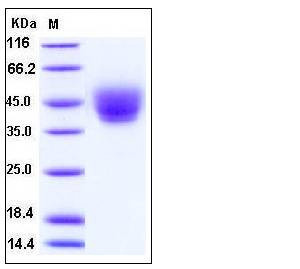| Catalog Number |
P10565-H08H |
| Organism Species |
Human |
| Host |
Human Cells |
| Synonyms |
DNAM-1,DNAM1,PTA1,TLiSA1 |
| Molecular Weight |
The recombinant human DNAM1 comprises 240 amino acids and has a predicted molecular mass of 27.6 kDa. As a result of glycosylation, rh DNAM1 migrates with an apparent molecular mass of 40-50 kDa in SDS-PAGE under reducing conditions. |
| predicted N |
Glu 19 |
| SDS-PAGE |
 |
| Purity |
> 97 % as determined by SDS-PAGE |
| Protein Construction |
A DNA sequence encoding the human DNAM1 (NP_006557.2) extracellular domain (Met 1-Asn 247) was fused with a polyhistidine tag at the C-terminus. |
| Bio-activity |
Measured by its binding ability in a functional ELISA . Immobilized human CD226 at 2 μg/ml (100 μl/well) can bind human CD112 with a linear ranger of 6.4-800 ng/ml. |
| Research Area |
Immunology |Cluster of Differentiation (CD) |T Cell CD Antigen |
| Formulation |
Lyophilized from sterile PBS, pH 7.4
1. Normally 5 % - 8 % trehalose, mannitol and 0.01% Tween80 are added as protectants before lyophilization. Specific concentrations are included in the hardcopy of COA.
|
| Background |
The cluster of differentiation (CD) system is commonly used as cell markers in immunophynotyping. Different kinds of cells in the immune system can be identified through the surface CD molecules which associating with the immune function of the cell. There are more than 320 CD unique clusters and subclusters have been identified. Some of the CD molecules serve as receptors or ligands important to the cell through initiating a signal cascade which then alter the behavior of the cell. Some CD proteins do not take part in cell signal process but have other functions such as cell adhesion. CD226, also known as PTA1 or DNAM-1, is a member of the immunoglobulin superfamily containing 2 Ig-like domains of the V-set. High rate of CD226 (Cluster of Differentiation 226) is found on the surface of natural killer cells, platelets, monocytes and a subset of T cells. CD226 have binding sites with CD112 and CD155 and mediate cellular adhesion to other cells containing its ligands. |
| Reference |
Zola H, et al. (2007) CD molecules 2006-human cell differentiation molecules. J Immunol Methods. 318 (1-2): 1-5. Ho IC, et al. (2009) GATA3 and the T-cell lineage: essential functions before and after T-helper-2-cell differentiation. Nat Rev Immunol. 9 (2): 125-35. Matesanz-Isabel J, et al. (2011) New B-cell CD molecules. Immunology Letters.134 (2): 104-12. |

